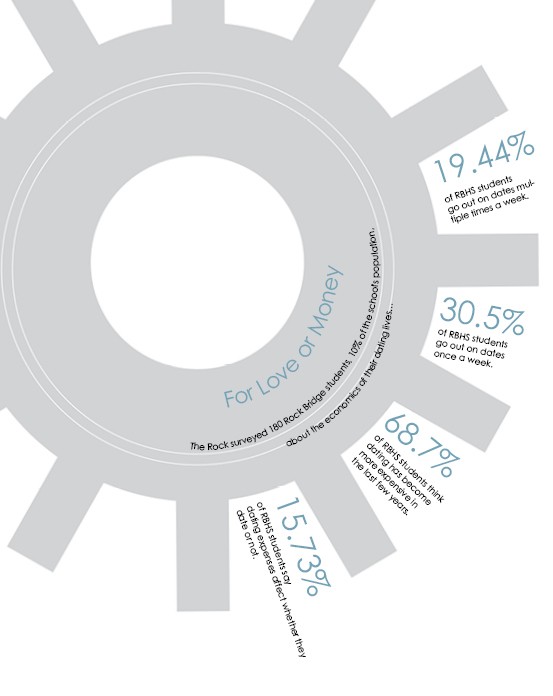Rage Against the Machine
The weak economy has effected Americans of all walks of life. The ROCK investigated how the economy has specifically affected teenage high school students in the Sept. 2012 issue.
Covering the cost of college 
The constant flow of assignments and exams overwhelmed sophomore Humera Lodhi when she entered her first year at RBHS. Setting the stress aside, Lodhi assured herself that her dedicated work ethic in high school would prepare her enough to enter college.
Little was Lodhi aware that the price of a higher education would be difficult for her to attain.
Only three years younger than her sister, who is a sophomore at the University of Missouri–Columbia, Lodhi has discovered a new set of concerns that affect her future, especially in terms of obtaining a college education. Lodhi’s previous aspirations of obtaining a professional degree and her mapped-out course of study in either journalism or history have suddenly become questionable because these high goals also come with substantially high price tags.
According to the Personal Financial Planning Department, 53 percent of freshmen borrowed federal loans to pay for the increasing costs of a college education. However, Deputy Commissioner for the Missouri Department of Higher Education Paul Wagner assures students that in Missouri the recent tuition increases at public institutions have been among the lowest in the nation, and there’s a lot of work in Missouri to try to keep tuition increases as low as possible.
Despite these efforts, the price for a higher education has not shown any signs of decreasing. But Wagner says these growing costs have a justifiable reason behind them.
“One of the major factors [for the rising costs for college] is the fact that the state funding going to colleges and universities has been going down and has been getting cut. And institutions have had to raise tuition to some degree to replace that loss of state funding,” Wagner said. “At the same time, things that colleges and universities have to purchase in order to operate continually get more expensive.”
With state funding running low and tuition costs on the rise, it’s not hard to imagine that financial support for students has also taken a fall in recent years. According to the Budget Office at the University of Missouri–Columbia of the $1.9 billion budget, “until 2004, state funding was the larger component of the operating budget, but state budget cuts in the early 2000s necessitated larger than normal tuition.”
However, in some cases, aspiring and dedicated students like Lodhi are depending on scholarships to assist with the demands of a higher education.
“For me, the most concerning part
of the tuition is the scholarships,” Lodhi said. “I want to try and get as many scholarships as possible, so I know I’ll
have to work hard. It is concerning, worrying about college and the rest of your life, but at the same time, trying to focus on high school, getting good grades and enjoying everything.”
The scholarships Lodhi hopes to receive have faced serious slashes in funding, which Wagner believes makes achieving a college education more challenging for students when resources like scholarships are being cut back, as well.
“The state funding for the universities and state funding for scholarships has also been decreasing. We have three main scholarship programs here in Missouri, and two of them have seen funding cuts over the past four or five years,” Wagner said. “The Access Missouri program, which is our main need-based scholarship that goes to low income and middle income students, has been cut the most. Bright Flight, our academic scholarship for people who get in the top three percent on the ACT, that award amount has been cut, as well.”
In an example, according to the St. Louis Post-Dispatch, the Access Missouri program previously provided between $1,000 and $2,150 for students who joined a state four-year college or university and between $2,000 and $4,600 for students who attended private institutions in Missouri. In 2010, the Access scholarships were cut to the point that for four-year institution scholarships would cut off at $950. Private college and university scholarships would provide a maximum of $1,900.
For five months senior Mariam Yahya has worked at The Great American Cookie in the Columbia Mall three to four days a week. With the costs of college escalating, Yahya realized she cannot solely depend on financial aid to cover her tuition, and succeeding in college depends on the amount of effort she puts into her job.
“Of course [the higher costs worry] my family and me, and my mom is always saving for me. We’re five [kids in the family] so [my mom] is thinking about all of us. Everyone in my family is getting a job or hoping to get a job and is going to work to save for their own college,” Yahya said. “All of us are working hard for our own future. Although the government and financial aid is going to pay some [tuition costs], it’s not going to pay all of my expenses.”
Regardless of tuition costs, there are options to prepare students like Lodhi and Yahya for the financial expectations of universities and colleges.
“If you haven’t really saved, and you are a high school senior or about ready to enter college, the most important thing you need to do is fill out the financial aid application. It’s called the FAFSA,” Wagner said. “You need to fill that out early and that will get you the best opportunities to earn grants and loans that can help you get into and afford a higher education.”
FAFSA is the largest supplier of student financial aid in the nation. The organization provides “$150 billion in federal grants, loans and work-study funds each year to more than 15 million students paying for college or career school,”Wagner said.
As Wagner suggested, financial preparation is important when considering college, but academic preparation is just as important. Wagner said a high percentage of students come into colleges unprepared for college-level work. These students have to take several developmental classes before they can start college, which only adds to expenses. According to a 2009 Columbia Missourian article, “10 percent, or about 600 students,
have been enrolled in Math 0110, the catch up course at MU.”
As an example of academic preparation for college, Wagner suggests students take Advanced Placement courses in high school because of their ability to rigorously prepare students for college, and save families thousands of dollars in college after passing a $70 to $80 exam.
However, for Yahya, who moved to America three years ago from Yemen and is still learning English, pursuing an Advanced Placement course would be much too rigorous. Still, such boundaries didn’t stop Yahya from striving to afford college.
“I’m taking math, and I am doing the dual credit. I got my payment this month [from my job], so I’m going to use that to get my math credit at Mizzou. Then I don’t have to take any math when I go to college,” Yahya said. “It’s not like AP, but I’m getting rid of a major thing.”
The path to higher education seems unrealistically difficult, full of twists of rising prices and turns of stressful preparation. Regardless, the RBHS graduation rate in 2011 was 94.8 percent and 62.5 percent of RBHS graduates attended a four year college or university, according to the Missouri Comprehensive Data System.
However, Wagner assures students the determination to pursue an education will pay off in the end.
“You have a much lower likelihood of being unemployed if you have a college degree. Once you have a job, you are much more likely to be promoted if you have a college degree. It’s pretty clear that a person’s lifetime or annual earnings are greatly enhanced if they persist to get a college degree,” Wagner said. “So it really is an investment in yourself, and an investment in your future that has a very high likelihood of paying off.”
Yahya realizes the importance of attending college through her continuous effort to defy any obstacles she may face. For Yahya and her family, success is the ultimate goal, for they “didn’t come to America to just go to high school and just find a job,”she said.
Yahya and Lodhi value the opportunity to receive a higher education, and despite the hurdles in their paths, they are determined to persevere.
“Education is overpriced, but that doesn’t mean I’m not going to go after it,” Lodhi said. “I want it bad enough that I’m willing to pay the price, literally.”
By Manal Salim
Property ownership conflict sparks unrest

The fate of many Columbia landowners’ property hangs in a state of uncertainty because of the controversy between Columbia city officials’ plans for development and the opposition of many Boone County residents. On Feb. 6, the city council unanimously decided to implement an Enhanced Enterprise Zone, covering 60 percent of Columbia. The EEZ is a plan meant to identify low-value or under-utilized property, and to improve it for commercial and economic growth.
However, when the city council decided to use EEZ in Columbia, the plan’s immense coverage affected not only commercial and business areas, but residential regions as well.
With the EEZ, the city would take many people’s property ownership into consideration for eminent domain, forcing owners to relinquish property in exchange for a sum of the property’s value.
This caused outrage among many Columbia residents and sparked groups such as Keep Columbia Free to take action, headed by its president Mark Flakne.
“We did originally start a petition drive; we called some city council members, especially some we thought had exhibited a more prominent betrayal of the things they ran for city council on,” Flakne said. “I think we will end up with an [smaller] EEZ, but originally the EEZ was to declare blight on 60 percent of Columbia and that is absolutely ridiculous. I mean, this town has been voted best place to live and the hardest working town in America.”
Since the EEZ came to the attention of Keep Columbia Free, they held rallies against the blighting of personal property, brought an EEZ analyst to talk of the negative effects and pressured the addition of more skeptical members to the EEZ board.
City council members responded to the startling response of opposition to the EEZ by changing much of the original plan. Ward 5 Council member Helen Anthony also feels that the decision was highly irregular compared to previous decisions made by the city.
“We received a report from REDI, our economic development arm of the city. They did a report on EEZ and sent us a value that they bring from communities that are trying to attract new business, so based on their report and recommendation we decided to start the process in Columbia,” Anthony said. “Although we abided by the state law in how we were setting up the EEZ in Columbia it really runs contrary to what we usually do. The groups rose up in protest because they felt that we should have had a public hearing and done the certification of the map.”
While groups such as Keep Columbia Free oppose the EEZ and are wary of its potential to tarnish Columbia’s community, neighboring town Boonville has shown how large corporations can coexist with a proud community.
Mayor Julie Thatcher said the casino, Isle of Capri, integrated well, even as it moved into a blighted area of the town, bringing many employment opportunities while maintaining good relations.
“After the flood of 1993, there was a large area down by the [Missouri] river that was greatly impacted by the flood; it is where the Isle of Capri is now. It helped to move that project along simply by the fact that it was a blighted area. It was a pretty depressed area before the flood; there were a lot of derelict houses and businesses there. There were a lot of vacant buildings. … It was a part of town that was not in very good condition,” Thatcher said. Isle of Capri casino “had a very good impact on Boonville. It has brought 500 jobs to Boonville, and I don’t know what we would do right now if we didn’t have the Isle of Capri as far as jobs go. They are a very good corporate citizen; they take care of property. They contribute to a lot of charitable organizations. … They give a lot of money back to the community.”
In Columbia’s original EEZ plan, businesses received a Tax Increment Fund if the company bought and built upon areas deemed by the EEZ as blighted.
The TIF would offer businesses a large incentive to purchase the property as they could be given a tax cut up to $500,000 for one year if they bought the property, a very attractive proposition for new developments.
Students such as senior Vikram Arun are not aware of the issue. Arun said the EEZ held potential to benefit Columbia, and although the plan went awry, there should still be a form of it implemented in Columbia.
“The EEZ is necessary to help Columbia’s [economic] growth, but in moderation because it could mess with other people’s property,” he said. “Things like the EEZ that can help create jobs are really important because more and more people are coming here than five years ago, so it’s necessary for it to help the [job] market.”
By Blake Becker
Couples confront cost of dating on one thin dime
In 2008, more than three million working Americans found themselves jobless, while income levels of other American workers substantially declined.
America and the rest of the world was in the midst of a global financial crisis that resulted in dramatically high levels of unemployment and left many of the world’s leading economies in a state of instability.

However, even as time passed and the effects of the recession lessened, the aftermath and recovery still holds part of many teenagers’ social lives.
Senior Lacey Reller and her boyfriend, senior Brandon Erbschloe, began their relationship by frequently going on dates and formal outings. However, this element of their relationship has been pushed aside because of work and budgeting around expenses.
“When we first started going out, we really did go out a lot, but now we usually just go to his house to hang out,” Reller said. “We would go out to Lakota … and get a coffee or something and go to the movies, but we haven’t gone out as much now.”
According to the U.S. Department of Labor, approximately a quarter of teenagers aged 16-19 years old are employed. The labor force participation rate for all youth, aged 16 to 24 years, actively working or looking for work was 60.5 percent in July 2012, a sharp rise from July 2011.
University of Missouri-Columbia associate of economics’ professor, Saku Aura, believes the current recession and the slow national recovery is having a substantial effect on teenagers.
“In Columbia a few years ago we had an extremely low unemployment rate, like one to two percent, and now we are at five to six percent, so it has gone up drastically,” Aura said. “For teenagers over the past few years, finding jobs has been harder because there is much more competition for jobs that teenagers would typically go for like basic service jobs [and] sales jobs. So at least for a while, the unemployment situation for teenagers has been going down.”
Head Research, on behalf of T.D. Ameritrade Inc., surveyed 1,001 teenagers who are a part of Generation Z, concerning their spending habits and attitude toward budgeting and the economy.
Of teenagers aged 13-22 years old, 76 percent believe saving money is of huge importance and a large part of their daily lives, while 41 percent of respondents said they have a budget they carefully follow.
Head Research also discovered that the majority of Generation Z’s main concern about the economy is jobs and unemployment.
This past summer, Reller held various baby-sitting jobs, while Erbschloe worked for Roots ‘N Blues developing an application. Reller and Erbschloe were not able to spend as much time with each other as they usually did because of time conflicts due to having a job.
RBHS sociology teacher Greg Irwin also believes because of the recent recession, many teens are more focused on working and saving extra money rather than spending it on gifts and dates.
“It’s harder for both guys and girls in high school to get jobs, and those with jobs are often required to work more hours for less competitive pay,” Irwin said. “The same is true for their parents, so some students have less disposable income to go on dates [and] attend social gatherings, while other students are working more hours and simply have less time to worry about dating.”
After being in a relationship for six months and planning for college, Reller has reevaluated her spending habits. While Reller enjoys shopping and spending money, she now considers herself a changed person in terms of her financial decisions.
“Sometimes we have to set boundaries,” she said. “There are times where we’re just like we have been going out a lot, we should probably just stay at home.”
This state of the economy required many teenagers to modify their traditional social and dating customs around the commitments of working and saving money.
Like Reller and Erbschloe, junior Michelle King and her boyfriend, senior John Daylor, also typically fix their time spent together around his work schedule and their budget.
Although King said the poor economy and her budget do not fully control what her and Daylor do with their free time, she admits that it does still make an impact.
“We definitely have to get creative with dates so we can keep them cheap and fun,” King said. “There are a lot of fun things you can do for free in Columbia. We like to go hiking, fishing or just walking in the park.”
Although couples like Reller and King have learned to adapt to working around work schedules and a budget, some hold the impression that it would be more expensive to go out with others because of beliefs that one might hold expectations for the social outing.
“I would presume that the biggest expectation for fancy dates and gifts comes from one’s family and the media,” Irwin said. “Many students’ parents who are still married have realized that a key element is to keep the relationship interesting and fresh. So going on trips and fancy dates builds up the anticipation in married relationships whereas the same newness and freshness comes more naturally to high schoolers because everything about the relationship is new for high schoolers.”
Although this expectation or mind-set that society instills into teenagers may not be as apparent in high school, it does exist.
As a single person in high school, junior Jimmy Song believes that although materialistic possessions are not the basis of a relationship, there is a social stigma to impress and fulfill one’s expectations.
“It can be [more expensive to be in a relationship], as a young person especially because we’re more likely to try to impress our dates. Money is definitely a factor. But I think that you can be just as frugal with money in a relationship as when a person is single.” Song said, “You can find something you both enjoy regardless of whether it costs money or not.”
The state of the economy has forced Reller and Erbschloe to reevaluate their spending habits and the way they date.
“I’m a spender, and I’m with him a lot, and it makes [me] more aware of what I’m spending, and it makes me want to save more,” Reller said. “I mean, you can save money and still have fun.”
By Jacqueline LeBlanc
















































































